
Running along Coyote Ridge in the Marin Headlands.
NPS maps of the Marin Headlands and the Presidio can be downloaded from the NPS Golden Gate National Recreation Area Maps page.

Running along Coyote Ridge in the Marin Headlands.
NPS maps of the Marin Headlands and the Presidio can be downloaded from the NPS Golden Gate National Recreation Area Maps page.
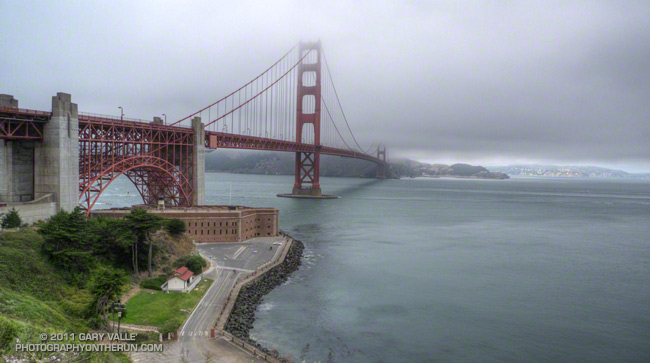
It was great to be cold. Cold instead of hot. Wishing I had gloves. The wind, chill and mist. So different than chugging up Edison Road…
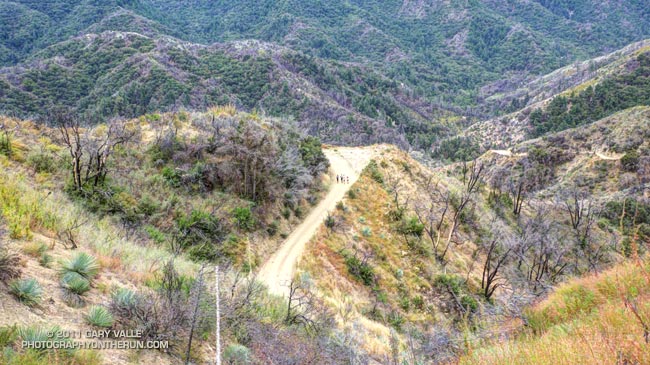
Runners on Edison Road During a Recent Training Run
Note: The Mt. Disappointment Endurance Run is now the Angeles National Forest Trail Race.
No matter if you run at the front, middle, or back of the pack, there’s the race you plan, and the race you run.
Based on the course info, it looked like the 7th edition of the Mt. Disappointment 50K was going to be more difficult than in 2009 and 2010, adding both mileage and elevation gain. Because of the closure of Mueller Tunnel and the damage done by the Station Fire and subsequent floods, we still wouldn’t be running up and over the shoulder of Mt. Disappointment, or down to Clear Creek and around Strawberry Peak, but the 2011 course would make up for that with its own very memorable sections.
To try and cope with the difficulties of the course, I’d put in extra miles and done more back to back Saturday-Sunday runs. But in one of those uh-oh moments a couple of miles into the race, I could feel in my legs that I was probably going to need to adjust my expectations. I wasn’t injured. I wasn’t getting over a cold or flu. My stomach wasn’t upset. I felt pretty good. But there was this nagging bit of fatigue in my legs…
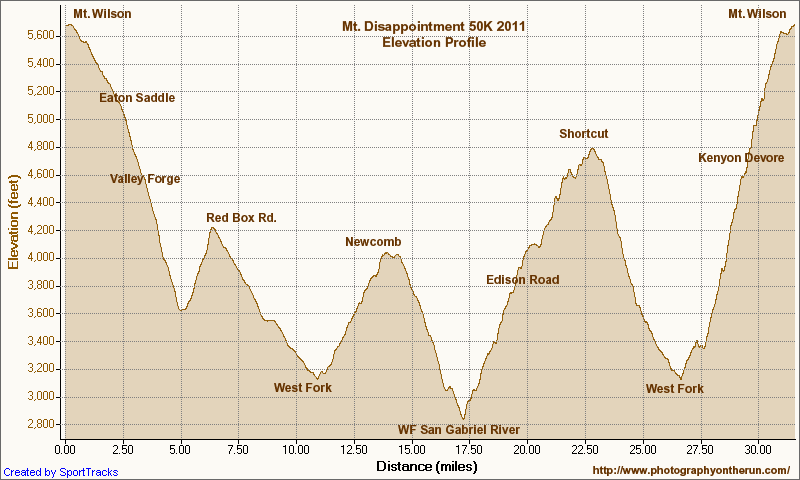
The new wrinkle for 2011 was that we turned off Mt. Wilson Road half-way to Red Box and ran down the Valley Forge Trail. In a training run a few weeks before the race, the Valley Forge Trail had been an obstacle course overgrown with Turricula (Poodle-dog bush). Trail work by Hilliard, Rowlan & Company had restored the trail, and today it was in great shape. Here’s an interactive Cesium browser View of the 2011 course and the courses in previous years, and an elevation profile of the 2011 course.
At the bottom of the Valley Forge we turned onto the Gabrielino Trail, and started up the canyon of the West Fork toward Red Box-Rincon Road. The change in grade from level to uphill confirmed it. I stepped aside so two running friends could pass. Maybe it was a tapering or over-training issue, or maybe it was just “one of those days.” Whatever, the legs were just not cooperating.
The irony is, this was probably a good thing. The day turned out to be the hottest of any Mt. Disappointment race to date. The lurking leg fatigue forced me to not push the pace, which made dealing with the temperature easier.
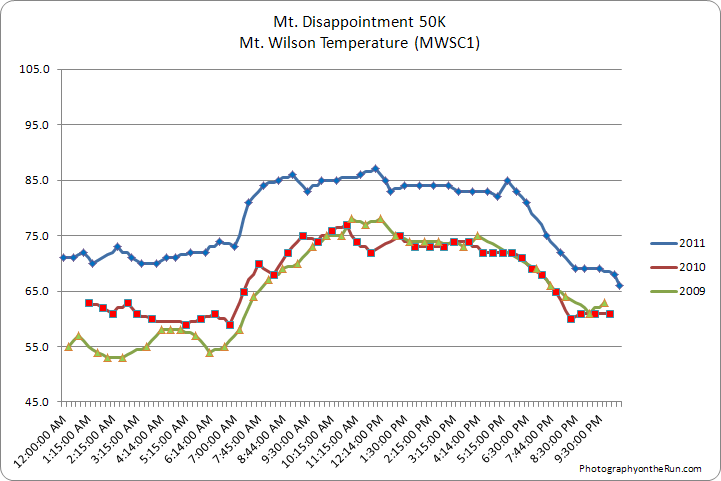
And hot it was! The forecast had looked decent just two days before the race, but Friday temperatures exploded in the mountains, jumping 10-12 degrees in 24 hours. The hot temps on Friday carried over into Saturday, making race day just that much warmer.
Here are the race day temperatures at Clear Creek and Chilao for 2005-2011, and Mt. Wilson for 2009-2011. And these temps are the temperature off the ground and in the shade! A better indication of the temperature in the sun is the “fuel temperature.” This is the temperature of a ponderosa pine dowel in direct sun. Here are plots of the race day fuel temperature at Clear Creek and Chilao for 2005-2011.
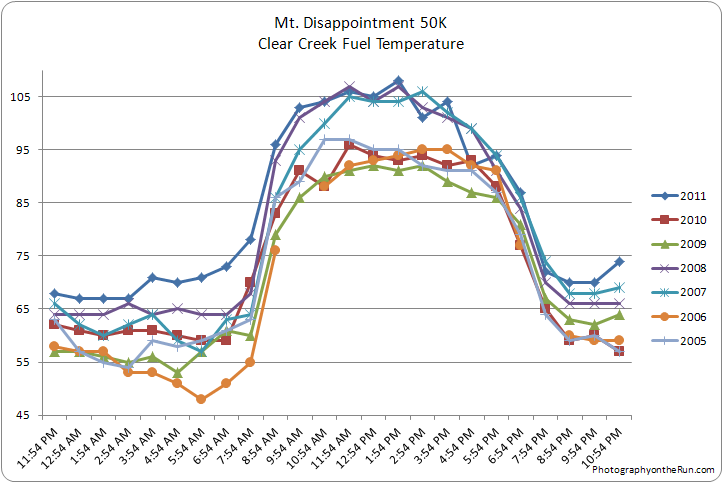
Because I wasn’t pushing the pace I didn’t hesitate to take a little extra time at aid stations. I can still feel that ice cold sponge on the back of my neck, and the cold water running down my back. This year there were numerous small stream crossings, and I think there was at least one small stream between every aid station. This was “free” cooling, and I paused a dozen times to dump water over my head. Thanks to the West Fork San Gabriel River, I was soaked from head to toe for the first steep, sun-baked section of Edison Road. This was also the case on the Silver Moccasin Trail in Shortcut Canyon and on part of Kenyon Devore.
Hot day or not there were some remarkable performances. Heather Fuhr was not only was the first place woman, she was fourth overall and set a new women’s course record of 5:07:11. Perennial favorite Jorge Pacheco sped through the tough Mt. Disappointment course in 4:46:29, winning the overall and setting a new course record in the Men’s 40-49 Division.
Once again the event was superbly organized by race director Gary Hilliard and the Mt. Disappointment 50K Staff, with the help of an extraordinary group of volunteers, runners, SAR personnel and sponsors. Thank you!
Related post: Mt. Disappointment 50K 2010 Notes
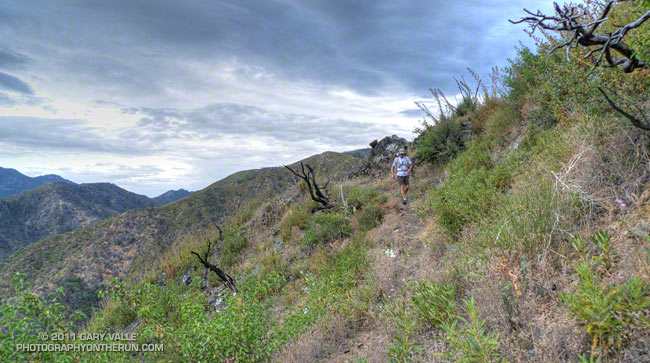
Note: The Mt. Disappointment Endurance Run is now the Angeles National Forest Trail Race.
The plan earlier in the week had been to do a day trip to the Sierra Saturday or Sunday and run the Cottonwood – New Army Pass loop, but computer models had shown a monsoonal flow developing, and a look at a satellite image Friday afternoon confirmed the forecast. Friday evening Whitney Portal was hit by a flash flood with water and mud reported up to waist deep in the campground. Runoff from the t-storms was increased by rain melting higher elevation snow, and by the ground already being wet from the prolonged melt of this year’s record-setting snowpack.
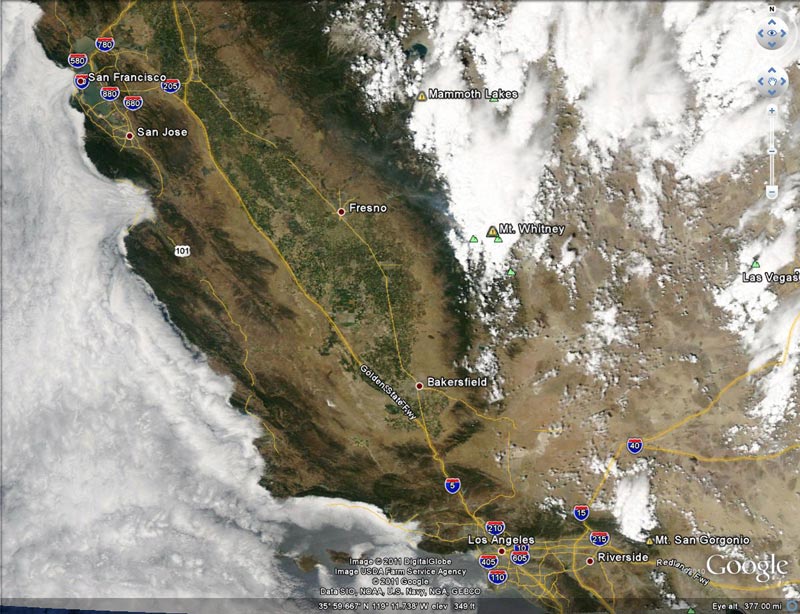
Computer forecasts indicated thunderstorms would likely continue in the mountains and deserts of Southern California through the weekend. Saturday I ran a few miles in the morning and then around lunchtime checked the weather in the Sierra. Strong thunderstorms had developed in the Southern Sierra, and a flash flood warning had been issued for the eastern slopes of the Sierra in the vicinity of Cottonwood Lakes Basin. Time to switch to plan B.
Plan B was to do a training run on the Mt. Disappointment 50K course. Mt. D is a figure-8 course, where each loop of the eight contributes about 16 miles and 3000′ or so of elevation gain/loss. Earlier this July there was a training run from Mt. Wilson on the Valley Forge – West Fork – Kenyon Devore part of the eight. Today we did another part of the figure-8 starting at Shortcut Saddle, running down the Silver Moccasin Trail to West Fork, then up to Newcomb Saddle, and then completed the loop to Shortcut on Edison Road. In the 50K, this loop would start at West Fork, but the sequence of trails would be the same.
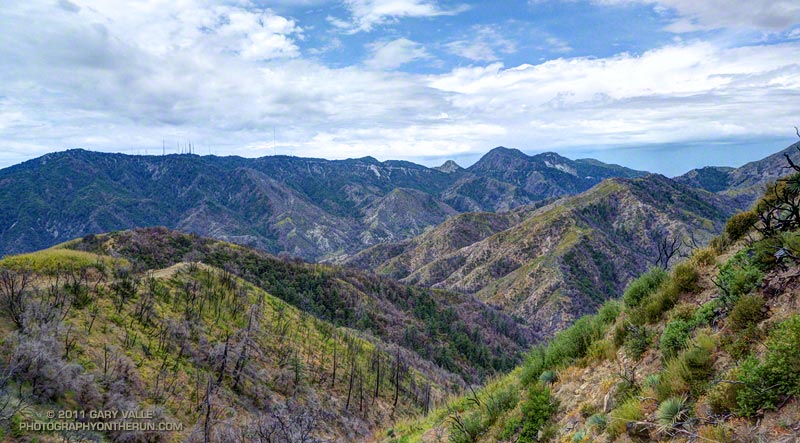
Along with the race-ending climb up Kenyon Devore to Mt. Wilson, the climb out from the West Fork San Gabriel River to Shortcut Saddle on Edison Road is one of the more “memorable” sections of the Mt. Disappointment course. At least Kenyon Devore has some shade. Even on a blustery Spring day the 5.5 mile climb up Edison Road (2N23) can be a warm one, and in direct sun in the heat of Summer it can be downright scorching. Not so today — a layer of monsoon clouds, a fresh breeze, and an occasional drop or two of rain kept the temperature on the ascent disturbingly reasonable.
The run worked out great, but may have been a bit misleading in terms of preparing for Mt. D. It’s unlikely we’ll have a giant sun shade for the race like we did today!
Note: Weather stations on Mt. Wilson and at Clear Creek can be used to get an idea of what temperatures are running in the vicinity of the race course. Note that the temeprature specified is measured in the shade. In my experience the “fuel temperature” is a better indicator of the temperature in the sun. The fuel temperature is included in the Clear Creek listing.
Some related posts: Mt. Disappointment 50K 2011 Training Run, Mt. Disappointment 50K 2010 Notes
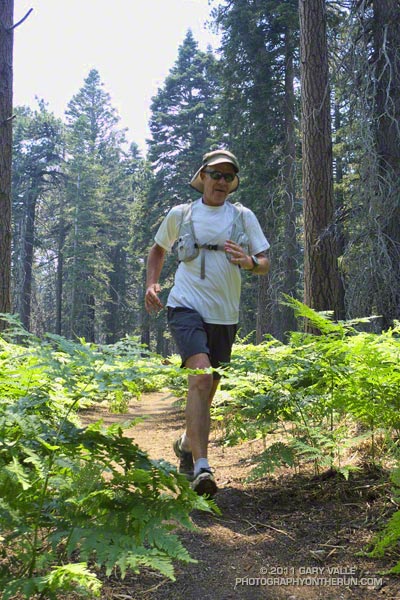
It had been about four months since I’d been to the summit of Mt. San Jacinto. Last time there had been several feet of snow, and the summit had been an inhospitable place with frigid temperatures and buffeting winds. Not so today. Short sleeves and running shorts were the attire of the day, and the weather was more like Malibu Beach than the summit of a 10,000 foot peak.
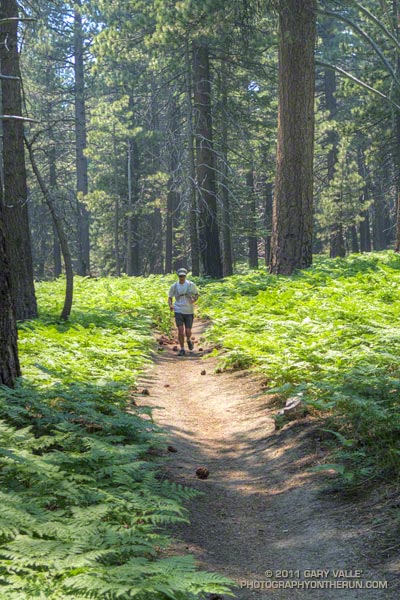
I was running with Craig Kinard, a long-time backpacker, but relatively new convert to trail running. With the help of Team CrossFit Academy, Craig discovered he likes to run up mountains, and has done well in both the Baldy Run to the Top and Mt. Wilson trail races. Next month he’s planning to run his first ultra — the Mt. Disappointment 50K.
Today we were doing an approximately 20 mile course from Long Valley (8400′), near the top of the Palm Springs Tram, up to San Jacinto Peak (10,834′), then down to the historic Tahquitz Peak Fire Lookout (8,828′). From the Lookout we would return to the Tram by way of Hidden Lake Divide. Totaling about 4000′, the ups and downs would be good training for the 6200′ of elevation gain in this year’s Mt. Disappointment race.
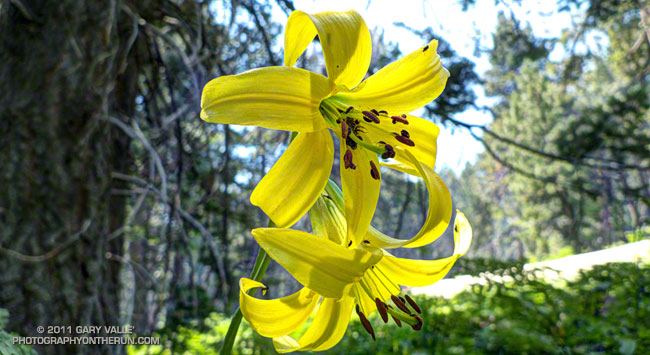
Winter snow translates to Summer water, and its beneficial effects could be seen in everything from the new growth on the chinquapin to the healthy green of the pines. Wellman Cienega was a green wonderland of ferns and corn lily, and near Skunk Cabbage Meadow bright yellow lemon lilies were sprinkled among the bracken and old growth Jeffrey pines. In places western azalea bloomed in profusion, its sweet fragrance mixing with the smells of damp earth and sun-warmed pine needles.
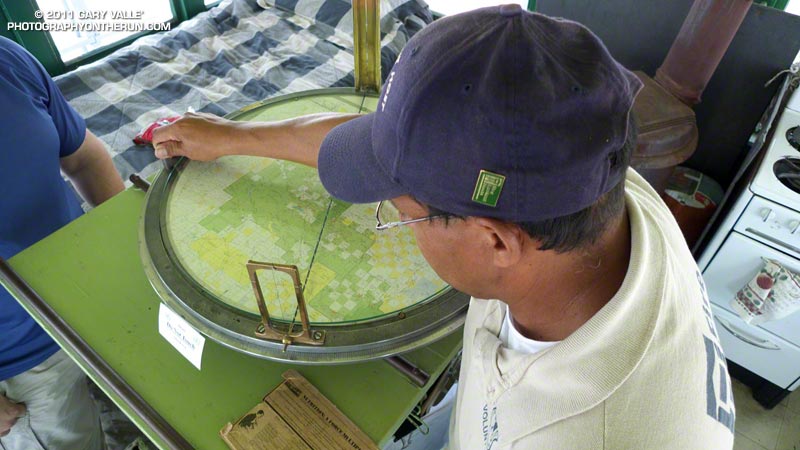
Smoke from the Eagle Fire remained trapped below a strong inversion most of the morning, and for a while views of Tahquitz Peak were crisp and clear. As temps warmed the inversion weakened and there was a flare-up on the Eagle Fire. By the time we reached Tahquitz Peak Lookout, a smoky haze had moved into the area.
At the fire lookout volunteer host Joe Mendoza described the history of the tower and demonstrated the use of the Osborne Fire Finder. Using an earlier sighting he plotted the location of the fire and showed us it was in the vicinity of Warner Hot Springs. He also showed us the “hot seat” used in lightning storms. Thanks Joe!
It was an outstanding run! Here’s a Cesium browser View of a GPS trace of the route, and an elevation profile generated in SportTracks.
Here are a few additional photographs:
Some related posts: Room with a View, Autumn Trail Running on Mt. San Jacinto, Mountain Weather
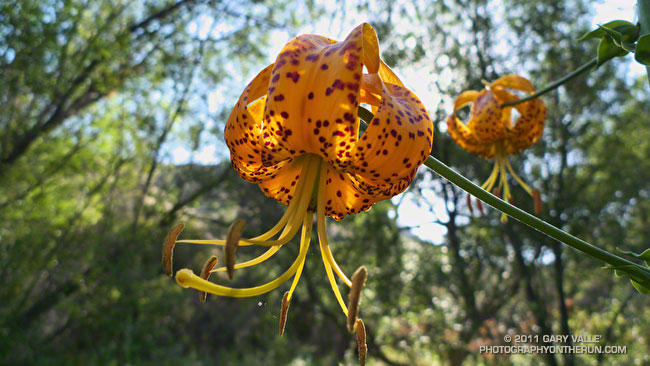
Was looking to get in a short run this morning and decided to check if any Humboldt lilies were blooming in Upper Las Virgenes Canyon.
The last time I’d seen Humboldt lilies bloom here was June 2006, following an unusually wet Spring and a two year period in which Downtown Los Angeles recorded 50+ inches of rain.
This Spring some months were wet and some months were dry, but December 2010 was the wettest in Los Angeles in 121 years. Add to the mix that the last two water years Los Angeles recorded above average rainfall, and it seemed there was a pretty good chance the Upper Las Virgenes Canyon lilies would be in bloom.
I’d seen lily stalks in other areas in recent weeks, and some blooming Humboldt lilies in the San Gabriel Mountains, but when I checked Upper Las Virgenes Canyon in early May, there had been none. But today there was — right in the middle of thorny patch of blackberry bushes.
Also blooming in the canyon were California wild rose and the non-native plant moth mullein — so named because of the similarity of the flower’s anthers to the fuzzy appearing antennae of a moth.
Related post: Humboldt Lily